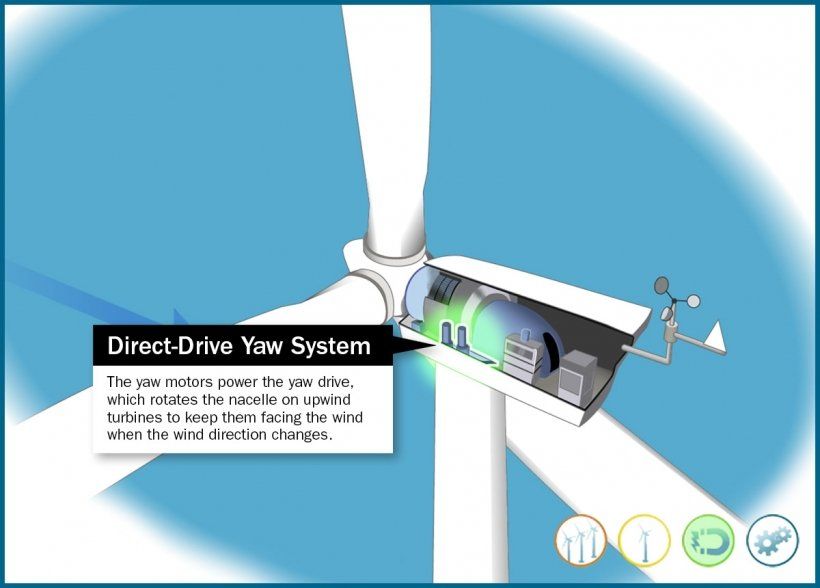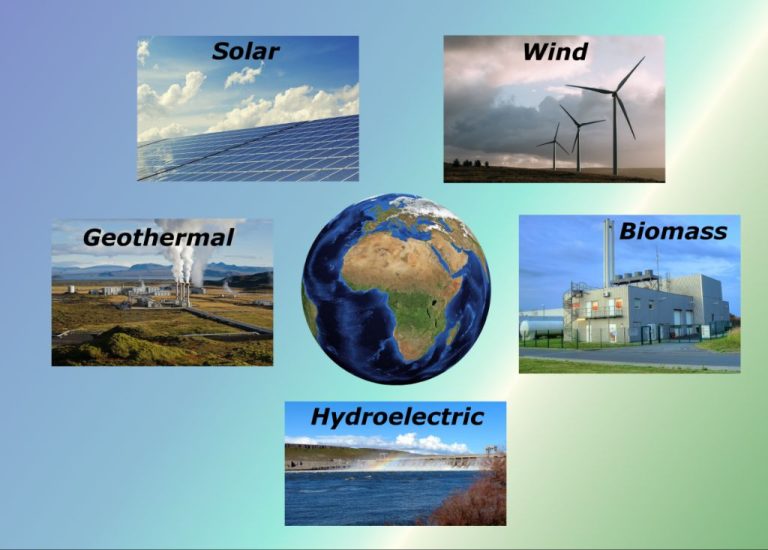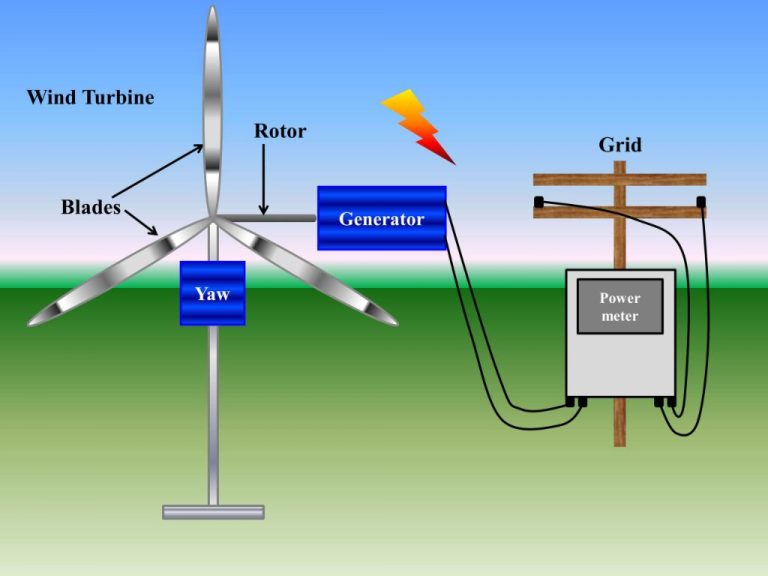Do Windmills Turn Towards The Wind?
Windmills are machines that convert the kinetic energy of wind into mechanical energy through the rotation of large propeller-like blades. For centuries, windmills have been an essential technology for grinding grain, pumping water, and generating electricity. At the heart of windmill technology is an important question: do the massive windmill structures turn on their own to face into the wind?
This article will examine how windmills are designed to automatically orient themselves in the optimal direction to harness the power of the wind. We’ll look at how windmills detect wind direction, use yaw drives to turn their housing structures, and actively track the wind to maintain the greatest efficiency. Understanding the technology that keeps windmills aimed at the wind provides insights into how these iconic structures are engineered to maximize renewable energy generation.

How Windmills Work
Windmills convert the kinetic energy of wind into mechanical power that can be used for electricity generation and other applications. The key components are the blades, rotor, shaft, gearbox, and generator.
The blades are shaped similar to airplane wings – flat on one side and curved on the other. When the wind blows across the blades, the curved surface catches more wind than the flat side, creating an area of low pressure. This difference in pressure results in a lifting force that rotates the blades. The mechanical power from the rotational motion spins a shaft connected to the rotor. Most windmills have a gearbox that increases the rotational speed from the low-speed rotor to a high-speed shaft suitable for driving an electrical generator. The generator uses magnetic induction to convert the mechanical power into electrical power.
So in summary, the kinetic energy of the wind is transferred into rotational kinetic energy by the blades, then mechanical power through the rotating shafts, which gets converted into electricity by the generator. The ability to capture energy from the wind and turn it into useful electricity is what makes windmills such effective renewable energy systems.
Wind Detection
Windmills use a wind direction vane or wind vane to detect the direction of the wind. The wind vane is mounted on top of the nacelle, which houses the generator and other equipment inside the windmill. It is a simple device consisting of an arrow-shaped object mounted vertically on a shaft. The wind vane is free to rotate 360 degrees and the arrow-shaped object acts as a sail, pointing into the wind.
As the wind direction changes, the wind vane automatically rotates to align itself with the wind flow. The rotation of the vane is transmitted to sensors inside the nacelle which send signals to the yaw drive mechanism about the current wind direction. Modern windmills may also use ultrasonic wind sensors or wind mapping technology using LIDAR (Light Detection and Ranging) to provide precise measurements of wind speed and direction.
By accurately detecting the wind direction in real-time, the windmill can orient itself properly to maximize energy production. The wind vane provides a simple, low-maintenance, and effective way for windmills to track changes in wind direction.
Orientation
For a wind turbine to operate efficiently, its rotor blades need to be facing directly into the wind. The nacelle, which contains the rotor and generator, is designed to pivot and turn so it aligns properly with the wind direction.
Most modern wind turbines have a wind sensor mounted somewhere on the nacelle that detects wind direction. This wind vane sends data to the turbine’s control system indicating which way the wind is blowing. The control system then activates the yaw drive mechanism to rotate the nacelle to the optimum orientation.
The yaw drive is comprised of electric motors and gearboxes that turn the nacelle and align it with the wind. Many large wind turbines have a 360-degree circular rotation range so they can orient in any direction as wind shifts. The yaw orientation process may occur gradually as wind direction changes, or more rapidly if wind conditions change abruptly.
Keeping the rotor facing into the wind allows it to harness the wind’s energy as efficiently as possible. Yaw orientation control systems maximize energy capture by ensuring the turbine is always oriented for optimal wind exposure.
Yaw Drive
The yaw drive is the mechanism that rotates the nacelle and blades to face the wind. It consists of electric motors and gearboxes that turn the nacelle on a large bearing mounted atop the tower. The motors receive signals from the wind vane to orient the turbine properly.
There are typically four gearboxes, each with an electric motor, placed around the circumference of the nacelle. The motors engage pinion gears into a large slewing drive gear that is attached to the tower. By coordinating the motors, the nacelle can be turned smoothly and accurately.
The slewing drive gear has an inner and outer race filled with roller bearings. The outer race attaches to the nacelle, while the inner race attaches to the tower. This allows the nacelle to rotate freely around the tower. The drive motors rotate the slewing drive gear and inner race, which turns the outer race and nacelle.
The yaw drive motors are very powerful, generating up to 700,000 Nm of torque. This allows the nacelle and rotor, weighing hundreds of tons, to be turned even in very high winds. The motors can rotate the turbine at about 0.25-1 degrees per second.
Active Yawing
Most modern wind turbines have a yaw drive system that actively turns the turbine into the wind. This maximizes power production by ensuring the rotor plane is perpendicular to the wind direction.
Wind vanes or ultrasonic anemometers mounted on the nacelle measure the wind direction continuously. This data is fed into a computerized yaw control system.
The yaw drive then uses electric or hydraulic motors to turn the nacelle. Gearboxes and bearings connect the motors to the tower top and nacelle, allowing smooth and precise alignment with the wind.
The yaw system tracks wind direction actively, turning the rotor into the wind whenever the direction changes. This active yawing keeps power production optimized as wind shifts occur.
Counter-Rotating Turbines
Most modern large wind turbines have a horizontal axis rotor with three blades spinning upwind of the tower. The rotor is connected to the generator inside the nacelle which converts the rotational kinetic energy into electrical energy.
Some wind turbine designs utilize counter-rotating turbines, which have two sets of rotors spinning in opposite directions on the same drive shaft. The counter-rotation helps capture more wind energy and reduces torque on the shaft.
In a counter-rotating design, one rotor spins clockwise while the other spins counterclockwise. Having two rotors enables the turbine to extract more energy from the wind, as the rear rotor can capture some of the turbulence coming off the front rotor. This results in higher efficiency compared to a single rotor design.
The counter-rotating setup also balances out much of the torque on the drive shaft, reducing stress on the mechanical components. Less torque enables the drive train to operate smoothly with less vibration and wear. Gearbox maintenance needs are also lowered.
Most large-scale turbines utilize an upwind rotor, meaning it spins on the windward side of the tower facing the incoming wind. Upwind rotors help avoid tower wake effects which can create turbulence for the blades. But counter-rotating designs allow for a downwind rear rotor since the front rotor helps smooth the airflow.
While counter-rotating turbines can capture more wind energy, the dual rotor system comes with added complexity. The capital costs are higher, and more routine maintenance is required to service two sets of machinery. As a result, the counter-rotating design is less common for utility-scale wind farms. But it remains an area of innovation to further improve wind energy production.
Maximum Efficiency
Active yawing allows wind turbines to orient themselves to face into the wind as it changes direction. This maximizes energy capture, as the most power is generated when the turbine blades are perpendicular to the wind flow. Without active yawing, the turbine would not be able to track changes in wind direction and would miss out on available energy.
Most large modern wind turbines have an active yaw system utilizing motors and gears. The yaw drive rotates the nacelle (housing containing the generator) so that the rotor faces into the wind. This is controlled automatically by a wind direction sensor called a wind vane, which sends signals to the yaw drive motors when an adjustment is needed. The turbine will then turn itself into the wind.
By keeping the rotor blades facing the wind at all times, active yawing enables wind turbines to harvest the maximum amount of kinetic energy available. This improves capacity factor, allowing the turbine to produce closer to its maximum potential output more consistently. Overall, active yawing increases annual energy production and return on investment for wind farm operators. It is a key technology that enables wind power to be an efficient and viable source of renewable energy.
Preventing Overheating
Wind turbines are designed to turn and orient themselves perpendicular to the wind to maximize efficiency. However, constantly facing the wind can cause overheating issues on the windward side of the turbine. As wind blows across the blades, it transfers heat to the surface, gradually heating up the side facing the wind. Over time, this can strain materials and reduce performance.
By rotating as winds shift, turbines distribute heating evenly across all sides. Turning the nacelle and blades prevents one area from overheating by dissipating the heat buildup across the entire surface area. This helps regulate temperature and prevents damage to turbine components. Yawing allows an even distribution of wind loads and prevents fatigue cracking from concentrated heat stress.
In addition, built-in sensors monitor temperature and can trigger yaw drives to periodically turn turbines to maintain optimal temperatures. So a wind turbine’s ability to track wind direction serves the dual purposes of maximizing power production and evenly distributing heat loads. Turning into the wind prevents overtaxing one side while harnessing energy most efficiently.
Conclusion
In summary, windmills are specifically designed to actively orient themselves into the wind in order to maximize efficiency and energy production. They achieve this through built-in wind direction detection and orientation mechanisms known as yaw drives. The yaw drive contains motorized wheels and gears that rotate the windmill housing, known as the nacelle, so that it always faces directly into the oncoming wind. This active self-orientation, or yawing, allows windmills to track changes in wind direction and keep their blades optimally perpendicular to the wind at all times. The ability to yaw is crucial for extracting the maximum amount of kinetic wind energy possible during operation. Without built-in yaw drives, windmills would be fixed in place and unable to achieve peak efficiency as wind shifts naturally occur. The specialized mechanics of wind direction tracking exemplify how modern wind turbine engineering focuses intently on optimal performance.



